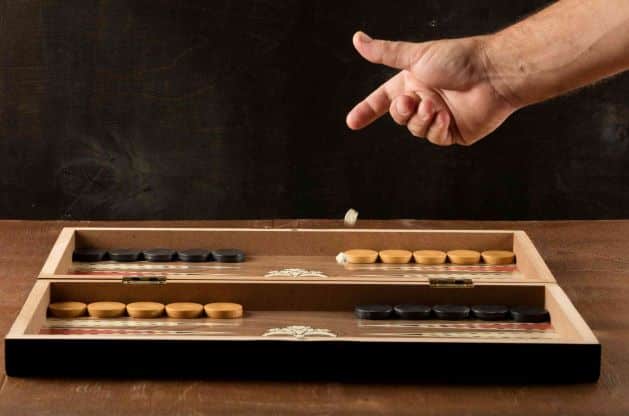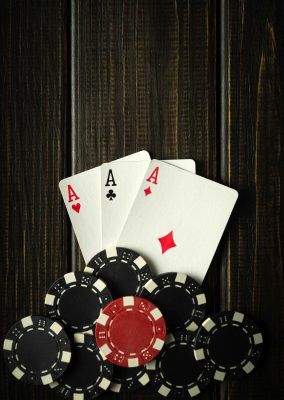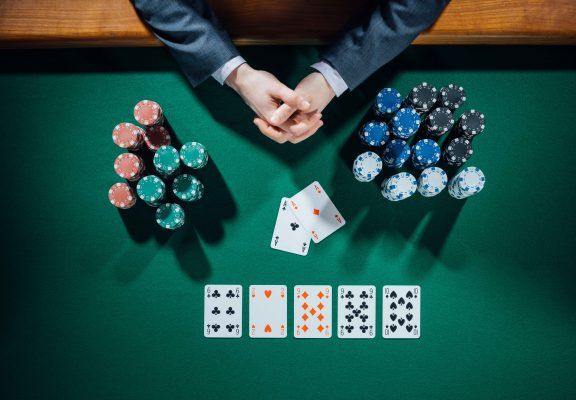Players of all ages can benefit from Backgammon’s positive effects on cognitive capabilities.
- The prefrontal cortex and the hippocampus are both exercised during play, which are parts of the brain responsible for memory formation and complex thought processes.
- The game’s strategic and tactical elements are ideal for stimulating these areas.
- Moreover, playing this board game reduces your risk of developing dementia or Alzheimer’s due to the mental stimulation it provides.
So, if you want to learn how to play Backgammon, you have come to the right place. But before I answer the main question of this article, I’ll provide information about the game’s origin, rules, and strategies.
Origin of Backgammon
Backgammon is among the most popular Western table games, and its roots can be traced back about 5,000 years to Persia and Mesopotamia, i.e., today’s Iran and Iraq regions.
Backgammon is a derivative of the Irish game that was first played around the 16th century. The first written record of Backgammon was found in 17th-century England.
Essential Information About Backgammon
Wondering how do you play Backgammon? It’s played between two people using a board with 24 triangles. Those narrow triangles are called points and are divided into four groups of six triangles that alternate in color.
Groups or quadrants are referred to as the home board and outer board. A ridge along the length of the board, known as the bar, separates the boards. Every point is numbered: for you, the outermost point is 24th, but at the same time, it’s 1st for your opponent.
Everyone starts with 15 checkers, stones, tablemen, or just men. All 15 are of the same color.
The following list is the Backgammon board layout, i.e., players begin with:
- five checkers on each player’s 6th point
- three men on each 8th point
- five on each player’s 13th point
- two checkers on each player’s 24th point
There are two dice per player. The current bet is displayed on a doubling cube with the numbers 2, 4, 8, 16, 32, and 64 printed on its faces. The goal of Backgammon is to move all of your pieces into your home board and then bear them off. The first person to do it is the winner.
Players roll a single die to establish who goes first, and the one with the greater number plays first.
How to Set Up Backgammon?
To understand what is Backgammon and how it’s played, I’ll dive more into the rules for setting up the board and the movement of pieces.
Board
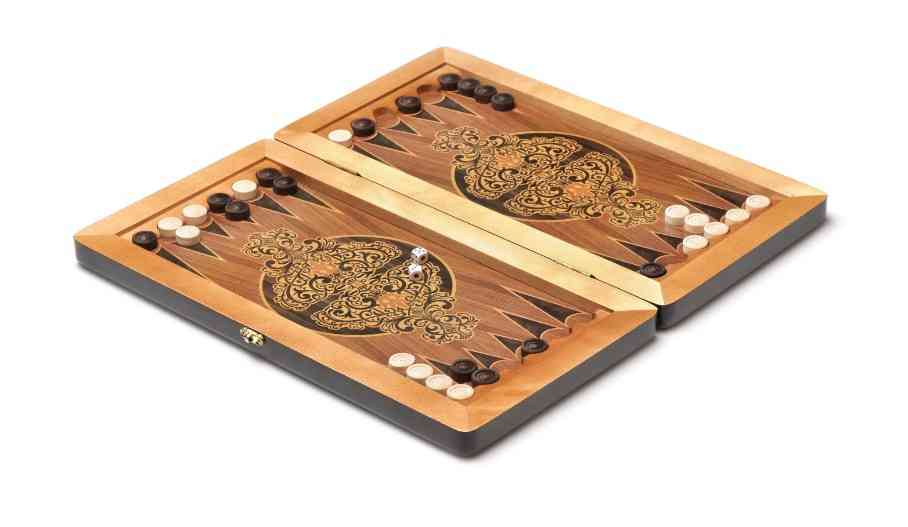
The board represents the single largest expense, as the price of tournament-sized models typically ranges from $250 to $1,300. The dice can turn many times on these boards because they don’t roll on top of the checkers or fall off the board. The boards can often be folded into little briefcases, making transporting them much simpler.
The board is divided into four equal sections and in two by a ridge that runs down the middle. This ridge is called the bar or middle bar. Another imaginary line divides the board into four quadrants: two home boards and two outer boards. We’ve already gone through how to set up the Backgammon process, but I want to focus on a couple more details regarding the initial layout.
Pieces
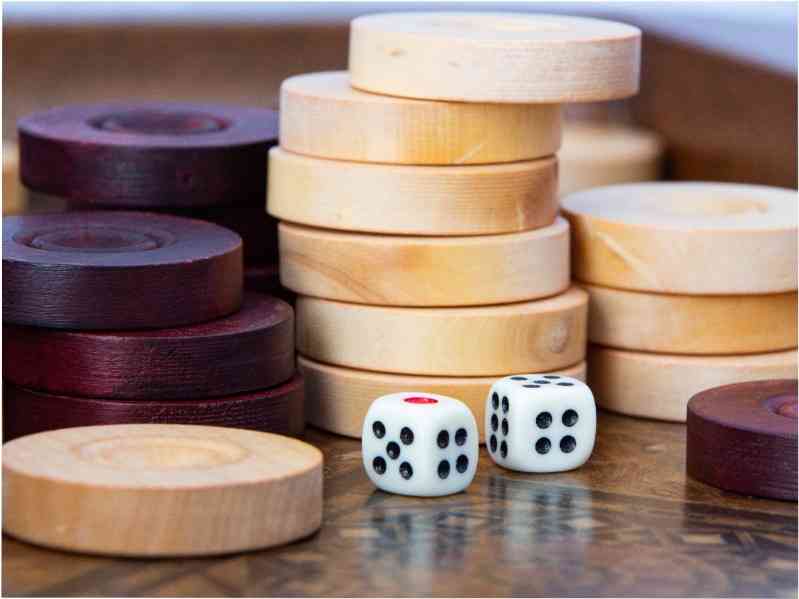
The movement of the pieces, referred to as stones, men, or checkers, along the points is determined by the player’s roll of the two dice. Each player begins the game with 15, which can be any one of several different colors.
Dice
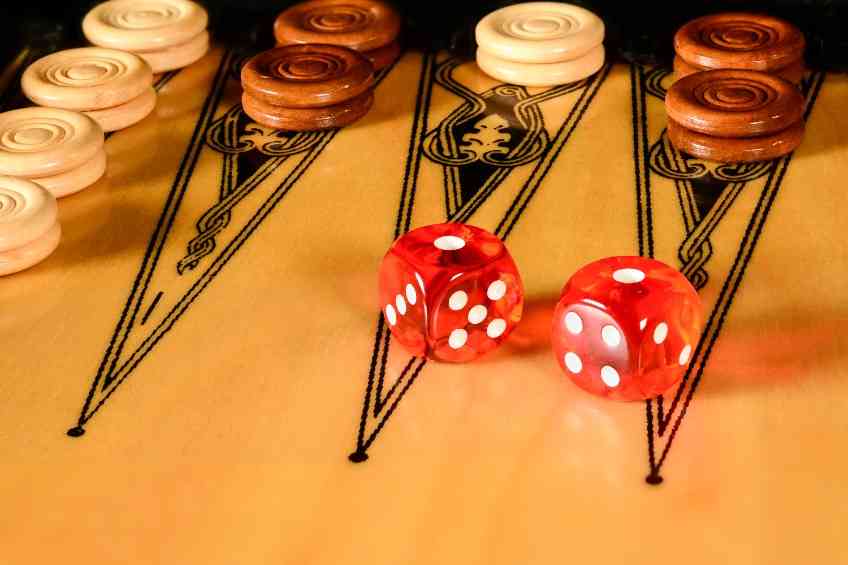
The players each have two ordinary dice with six faces and numbers ranging from one to six. Most Backgammon players who take the game seriously opt to use precision dice. These dice have round corners, allowing them to roll more frequently and unpredictably. The dice will typically correspond in color to the pieces, but that doesn’t have to be the case.
Some players prefer clear dice because they feature an internal marking that makes it simple to determine whether or not an opponent is attempting to cheat by exchanging good dice for crooked dice that have been weighted to generate more favorable results. Note that cheating can be avoided by using dice shakers or mugs.
Last but not least, each Backgammon set comes with a doubling cube, a die with six sides, and the numbers 2, 4, 8, 16, 32, and 64 on them. This die is used to increase the amount at stake in a game.
How to Play Backgammon: Step-by-Step Instructions
Tablemen are moved by the person who rolled the higher number, using the numbers on both dice. Once the initial roll has been made, each player will throw two dice and take turns. A player’s next move is determined by the number of points, or ‘pips,’ shown on the dice.
When moving the pieces, you must follow these rules:
- The pieces are always moved forward to a lower-numbered point.
- A checker can only be moved to an unoccupied point, not taken by two or more opposing pieces.
- Two numbers on the dice give you different options. If you roll a four and a two, you can move one piece four spaces to an open point and another two spaces, or you can combine and move the same checker a total of six spaces, provided that one of the intermediate points, which would be the fourth and second place from the starting point, is open as well.
- If you roll a double, the number on the dice is played twice.
- If it happens that you roll a pair of sixes, you’ll have four sixes at your disposal and can use them to advance the pieces as he sees fit.
- If allowed by the rules, you must use both numbers of a roll or all four in case of a double. If only one number can be played, you’re obliged to do so.
- If both numbers are playable, but there’s only one place available, you’re obliged to play a bigger number.
- When you can’t use either number, your turn ends.
- In the case of doubles, if all four numbers can’t be played, you’re obliged to play as many as possible.
Entering, Moving & Hitting
When you understand these basic Backgammon rules, you can move on to the next area: moving, hitting, and entering. There is only a couple of essential regulations, but the similarity of moves with those from other games compels me to go through all:
- A blot is a position on the board where just one checker of both colors is stationed. A blot is hit and moved to the bar if the opponent’s checker lands on it.
- The first duty of any player with pieces on the bar is to move them onto the opponent’s home board. To enter the game, a piece must be moved to an empty square whose value matches that of the dice.
- If you roll a three and a five, you can move a checker onto the opponent’s third or 6th point, provided that the prospective point isn’t already home to two or more of the opponent’s pieces.
- In case you try to move while neither of the points is available, you lose your turn. But, if you can only enter a portion of your checkers, you must enter what you can and forego the rest of your turn.
- Any remaining numbers on the dice must be played after all your checkers have been entered, either by moving the entered checker or a different checker.
Next on the list of instructions for Backgammon are doubling and a more comprehensive outlook on bearing off.
Doubling
When playing Backgammon, the stake is determined per point. Every game begins at one point. If you have a significant edge at any moment in the game, consider raising the stakes or doubling. This can only happen at the beginning of your turn before the dice roll.
If you’ve been offered a double and declined, you’ll lose the game and must pay one point as a penalty. On the other hand, you can take the double and continue playing for the bigger stakes. After accepting a double, you can request the next one.
Redoubles are repeat doubles within the same game. If you decline a redouble, you’re responsible for covering the original number of points at stale before the redouble. If not, you get possession of the cube, and the stakes are doubled from there on. Every player can redouble at any time during the game.
Bearing Off
You can begin bearing off once all 15 checkers have been placed on your home board. To bear off a checker, you must first roll a number that corresponds with the point where the piece is located. For example, you must roll a six to remove a checker from the sixth point.
To bear off, you must make a move by placing a checker on a higher-numbered point if there’s no piece on the point that you rolled. If there are no other checkers on a higher numbered point, you can and should remove your piece from the highest point. Any time a player has the option to make a valid play, he doesn’t have to bear off.
In order to bear off, all of your live pieces must be within your home board. If you hit the piece while bearing off, you need to return that piece to the home board before you can resume to bear off. You win the game if you’re the first to bear off all the pieces.
Gammon and Backgammon
Knowing how to play Backgammon helps you minimize your losses. For example, if you remove at least one checker from the board before the end of the game, you’ll only be penalized the value that’s displayed on the doubling cube.
However, you’re Gammoned and lose twice the value of the doubling cube if you haven’t borne off any of your checkers before the game ends. Alternatively, if you don’t bear off any pieces and still have a checker on the bar or in the winner’s home board, you’re Backgammoned and lose three times the value of the doubling cube. This is the worst possible outcome for the loser.
Additional Rules in Backgammon
The following guidelines are frequently applied in practice:
- Automatic doubles
- Beavers
- The Jacoby rule
Automatic doubling is an optional rule. The stakes are immediately increased if both players turn the same number on the first roll. The doubling cube now reads two and is kept in the middle. Usually, players agree that there will only be one automatic double throughout each game.
After a player has doubled, that player can redouble or beaver instantly while maintaining ownership of the cube. As with a standard double, the original Doubler can accept or decline the double.
With the Jacoby Rule in play, it’s only possible to count Gammons and Backgammons as a single game in the event that neither player has offered a double for the game’s duration. This rule helps speed up the game by removing circumstances in which a player would want to avoid doubling to continue playing for a gammon.
Irregular Moves in a Game of Backgammon
Any comprehensive ‘How to play Backgammon’ guide also needs to emphasize illegal moves.
Both dice must land flat on the surface of the right-hand portion of the game board after being rolled together. If either die lands outside the right-hand board, on a checker or if it doesn’t land flat, you must re-roll both dice.
The turn is considered complete when you pick up dice at the end of the round. If the play is invalid or unfinished, you can either accept it as it is or ask the player to make a valid move.
The result of a roll is nullified if you roll before the opponent has finished his turn and picked up the dice to end the game. However, this rule is often disregarded.
In Backgammon, the concept of a stalemate is practically impossible. It can only occur when both players actively prevent the other from moving forward. Both of them may have prime in front of the other player’s checkers.
Both players can only maintain their prime positions once they are pinned to the bar. Therefore, if both players are currently on the bar, one of them will ultimately re-enter the game unless both players are eliminated at the same time.
The only way to reach a deadlock is for both players to be on the bar simultaneously and for both players to be closed out. However, this scenario isn’t going to play out. If you are on the bar and your opponent closes the gap, you can’t hit your opponent. So, stalemate is possible only if one of the players performs a move outside the rules.
Strategies for Backgammon You Can Employ
The dice rolls determine the outcome of a game of Backgammon; therefore, if your opponent rolls 6s while you roll 1s, you’ll likely lose regardless of what you do.
Considering there are so many throws of the dice in a game of Backgammon, the luck tends to equal out, and the player who employs the superior strategy is most likely to emerge victorious. Therefore, learning the ins and outs of these methods is essential if you want to become proficient in Backgammon.
So, in addition to the rules for Backgammon, you’d want to check out a rundown of the five fundamental Backgammon strategies: the blitz, the running game, priming, the holding game, and the back game.
The Blitz
The Blitz is an all-out assault against your opponent’s weak checkers in one or more areas. Instead of just running for home or attempting to create points along the board, this approach emphasizes landing on your opponent’s checkers whenever possible to send them to the bar.
The advantage is that you’re setting your opponent back a certain number of pips, and it also allows you to trap certain checkers on the bar if your opponent doesn’t roll the appropriate numbers to come back onto the board.
Remember that attacking close to your home row doesn’t cause your opponent to lose a significant number of pips and that if your attacking checker remains susceptible, you run the chance of losing a significant number of pips yourself.
The Running Game
The Running Game is the most basic Backgammon board game strategy. It entails moving your checkers toward your home board in the quickest possible manner. If you and other players want to engage in a running game, the match’s victor will be determined by who rolls higher than the other. Having this in mind, you should only commit to a running game if you start with powerful rolls at the beginning of the game.
Priming
A connected series of made points along the board is an important part of the Backgammon strategy known as priming. Many experts consider this the most crucial technique when learning to be successful at Backgammon.
You have formed a wall that your opponent cannot get around until they roll a five or a six. This wall slows down your opponents and makes it simple for your other moving pieces to find safe locations by providing an easy target.
Priming is the most efficient when used in conjunction with the blitz, referred to as the two-way forward offensive. Your opponent’s checkers will be placed on the bar due to the blitz, and getting off the bar can be challenging. This will cause your opponent to waste a lot of dice rolls.
Holding Game
As you move away from your home board, the Holding Game depends on maintaining an anchor point in your opponent’s home board. Leaving an anchor point on the opponent’s home board provides you with two advantages, although it’s frequently prudent to advance your furthest checkers early in the game to prevent getting trapped.
For defensive purposes, it provides you with a secure position to fall back on in the event that one of your checkers is sent to the bar. This stops an opponent from entirely baiting you into an automatic defeat.
When playing offensively, the Holding Game allows your anchor to provide a reasonable threat to the pieces that your opponent is advancing. Even if your opponent responds by capturing one of your checkers from your home board, you’ll still come out on top in terms of pips if you capture a checker from your opponent’s home board.
Back Game
The Back Game is an extension of the Holding Game that focuses on keeping numerous points on your opponent’s home board. Considering that you begin the game with only two checkers on your opponent’s home board, it’s obvious that the only time you’ll play this strategy is if your checkers are repeatedly knocked onto the bar.
The Back Game is a backup strategy. Some call it a last-ditch effort to save face when losing badly. This tactic not only makes your opponent’s life more difficult by increasing the offensive threat of the Holding Game, but it also makes your life more difficult by taking up a valuable part of the home board.
Conclusion
To wrap up, I all reiterate a couple of the most important rules and guidelines you must know to learn how to play Backgammon.
It’s a board game between two people with 15 checkers. The winner is the first player to put all his pieces into a quadrant of the board, i.e., the home board. To do that, players use dice or doubling dice if doubling has already occurred.
In this Backgammon guide, I’ve explained all the rules, complimented with the list of irregular moves and the standard tactics that will help you win when you start playing it.
FAQ
How do you start a Backgammon game?
To decide the Backgammon starting position, you and the other player roll a single die to determine who goes first, with the higher of the two getting the first turn. If you roll the same number, you need to repeat the action. After that, you alternate turns and roll two dice at the beginning of every turn.
What is an object of Backgammon?
The object of Backgammon is to be the first player to remove all pieces from your inner table, which is called bearing off. If the opponent removed at least one piece, you win a single game and receive the current stake. If he doesn’t remove a single piece, this is a ‘gammon,’ and it’s worth double the current stake.
Is it hard to learn to play Backgammon?
The rules are easy to understand, and a new player can pick them up in a matter of minutes. Furthermore, these rules are easy to grasp once you’ve played a couple of games. It’s easy to see why so many people keep coming back to play it and why it remained popular after thousands of years.
Why is the 5-point important in Backgammon?
The 5-point is deep in your home board, along with the 6-point, which is effective protection when your opponent is trying to re-enter from the bar. When your opponents roll a five or a six, they’ll fail to re-enter and, as a result, waste a lot of their pips.
